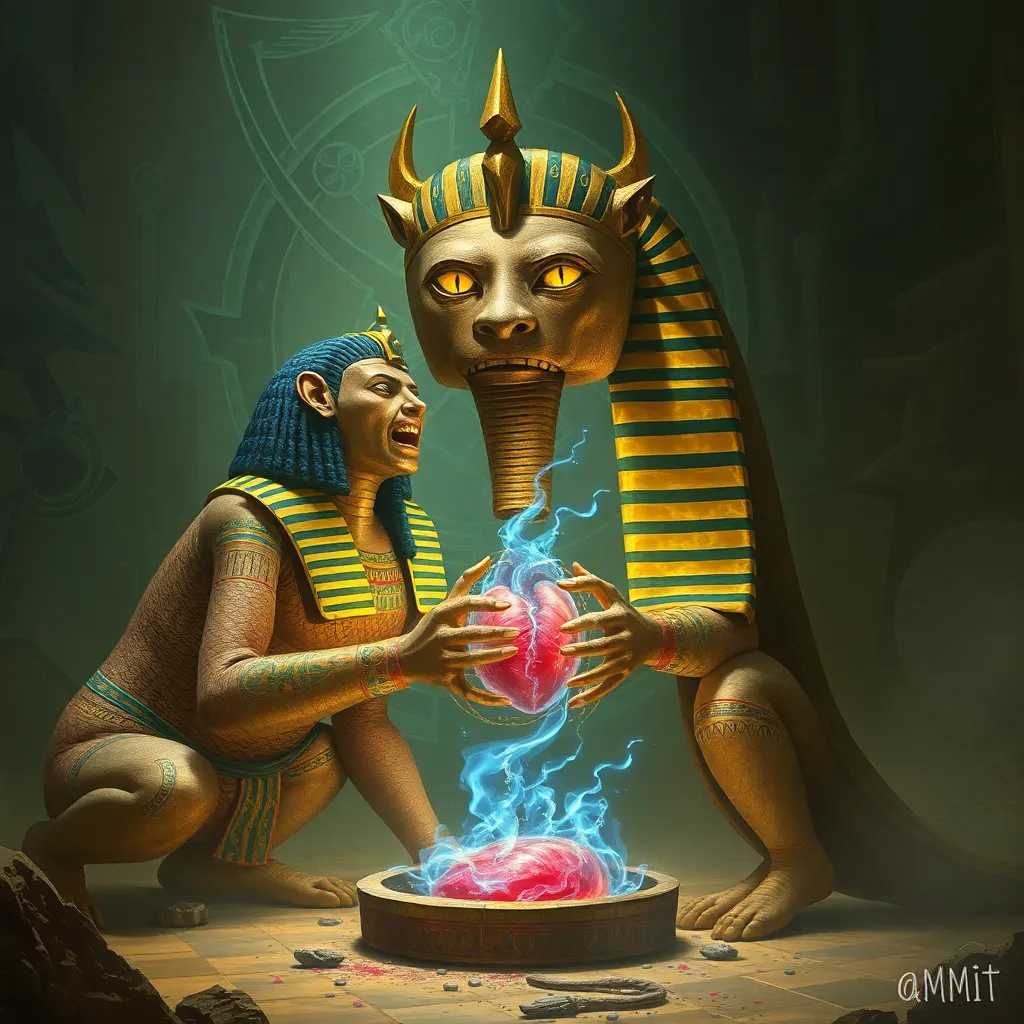Ammit: The Devourer and the Weighing of the Heart
I. Introduction
Ancient Egyptian civilization was deeply rooted in the belief of the afterlife, where the soul’s fate was determined by a divine judgment. This belief system revolved around concepts of morality, justice, and the eternal consequences of one’s actions during life. Among the various deities associated with this judgment process, Ammit stands out as a fearsome figure representing the finality of divine justice.
Ammit, often referred to as the “Devourer of the Dead,” played a crucial role in the weighing of souls, a ceremony that determined the worthiness of an individual to enter the afterlife. Her presence served as a stark reminder of the consequences of a life led by wrongdoing.
II. The Mythological Origins of Ammit
Ammit is depicted as a fearsome creature with a hybrid form, combining the features of three of the most powerful predators in ancient Egypt:
- Crocodile: Symbolizing strength and ferocity.
- Lioness: Representing courage and the hunt.
- Hippopotamus: Associated with chaos and danger in the Nile.
This unique combination of traits made Ammit a powerful and terrifying figure in the Egyptian pantheon. The myths surrounding her origin suggest that she was created during the process of establishing order in the universe, serving as both a guardian and a punisher of souls. Her very existence underscores the importance of ethical conduct and the consequences of one’s actions.
III. The Weighing of the Heart Ceremony
The Weighing of the Heart was a pivotal ceremony in ancient Egyptian funerary practices, conducted in the Hall of Maat. During this ceremony, the deceased’s heart was weighed against the feather of Ma’at, the goddess of truth and justice. The process included several key figures:
- Anubis: The god of mummification and the afterlife, Anubis was responsible for guiding souls to the judgment chamber and overseeing the weighing process.
- The Heart: Considered the seat of intelligence and emotion, the heart was believed to contain the soul’s deeds. A heavy heart indicated a life filled with wrongdoing.
- The Feather of Ma’at: This feather represented truth and justice. A soul that was lighter than the feather was deemed worthy of entering the afterlife.
If the heart was found to be heavier than the feather, it was deemed unworthy, leading to dire consequences involving Ammit.
IV. The Role of Ammit in the Afterlife
Ammit’s role in the afterlife was that of a devourer of the unworthy. After the judgment, if a soul failed to pass the test, Ammit would consume the heart, leading to a fate worse than death. The consequences of being devoured by Ammit included:
- Loss of Identity: The individual would cease to exist, their name and soul obliterated.
- Eternal Damnation: This fate was viewed as a form of eternal punishment, where the soul would be trapped in a state of non-existence.
This aspect of Ammit’s mythology introduced the concept of eternal damnation, a powerful motivator for ethical behavior in ancient Egyptian society.
V. Symbolism of Ammit in Ancient Egyptian Culture
Ammit held significant symbolic meaning in ancient Egyptian culture:
- Justice and Morality: Ammit represented the harsh reality of divine justice. Her role as the devourer emphasized the importance of living a moral life.
- Cautionary Figure: By embodying the consequences of wrongdoing, Ammit served as a warning to individuals to adhere to ethical standards.
- Artistic Depictions: Ancient artifacts often portrayed Ammit in various forms, highlighting her hybrid nature and her role in the judgment process.
Through these representations, Ammit became a powerful symbol of the balance between good and evil in the afterlife.
VI. Comparisons to Other Mythologies
Ammit’s attributes and role in the afterlife draw parallels to figures from other mythologies, illustrating a universal theme of judgment:
- Greek Charon: The ferryman of the dead, Charon transported souls across the river Styx, symbolizing the journey into the afterlife.
- Hindu Yama: The god of death and the ruler of the afterlife in Hindu belief, Yama also judges souls based on their deeds.
These figures, like Ammit, represent the inevitability of judgment and the consequences of one’s actions, reinforcing the importance of ethical living across cultures.
VII. Modern Interpretations and Cultural References
In contemporary society, Ammit has found a place in various media and literature:
- Movies and TV Shows: Ammit has been featured in films and television series, often as a symbol of justice or vengeance.
- Literature: Modern authors have drawn on her myth to explore themes of morality and the afterlife in fictional narratives.
- Spirituality: Ammit’s image is sometimes used in modern spiritual practices, symbolizing the commitment to living a just life.
The resurgence of interest in ancient Egyptian mythology has allowed Ammit to remain relevant in discussions about ethics and morality today.
VIII. Conclusion
Ammit’s significance in ancient Egyptian beliefs cannot be overstated. As the devourer of the unworthy, she embodies the consequences of a life lived without regard for morality and justice. The Weighing of the Heart ceremony, with its intricate symbolism and divine judgment, reflects the enduring legacy of this powerful myth.
In a world where ethical dilemmas continue to challenge society, Ammit serves as a reminder of the importance of justice and moral integrity. Her myth, steeped in ancient wisdom, invites reflection on the choices we make and their impact on our lives and the lives of others.




